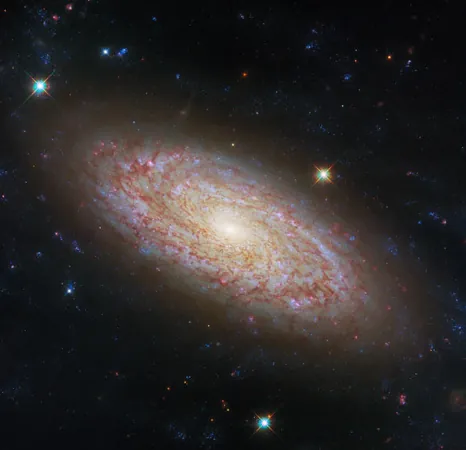
Hubble Space Telescope Captures Stunning Images of the Flocculent Spiral Galaxy NGC 2090
2024-11-25
Author: Arjun
Astronomers using the NASA/ESA Hubble Space Telescope have unveiled a breathtaking new photograph of the spiral galaxy known as NGC 2090. Nestled in the southern constellation of Columba, this galaxy is sometimes referred to by its other names, including ESO 363-23, IRAS 05452-3416, and LEDA 17819. It was first discovered on October 29, 1826, by Scottish astronomer James Dunlop.
NGC 2090 has gained prominence in astronomical studies as a significant component of Hubble’s Extragalactic Distance Scale Key Project. This ambitious initiative was designed to refine the Hubble constant, a critical quantity that helps define the rate of expansion of the universe. In a groundbreaking study from 1998, researchers measured the distance to NGC 2090, utilizing Cepheid variable stars, which led to a distance estimate of 37 million light-years away. More recent observations in 2020 employed the Tully-Fisher distance method, revealing that NGC 2090 is, in fact, about 40 million light-years distant from Earth.
This galaxy is particularly captivating to astronomers due to its active star formation, making it a prime subject for further investigation. Described as a flocculent spiral galaxy, NGC 2090 features a patchy, dusty disk with spiral arms that can appear somewhat uneven or "flaky." The latest Hubble image vividly illustrates this description, showcasing winding lanes of light that emerge through the obscuring dust.
Further emphasizing its dynamic nature, NGC 2090 houses clusters of stars in various evolutionary stages, with active regions of star formation spread across its disk. Observations taken in October this year by Hubble aimed to explore the processes of star formation and the movement of matter within galaxies.
In addition to Hubble’s work, the NASA/ESA/CSA James Webb Space Telescope has also focused on NGC 2090, contributing valuable infrared data that enhances our understanding of galaxy evolution. Together, these observations pave the way for a more comprehensive picture of how galaxies like NGC 2090 form and evolve in our universe.
Stay tuned for more astonishing findings from these powerful telescopes, as they continue to unlock the mysteries of the cosmos!



 Brasil (PT)
Brasil (PT)
 Canada (EN)
Canada (EN)
 Chile (ES)
Chile (ES)
 España (ES)
España (ES)
 France (FR)
France (FR)
 Hong Kong (EN)
Hong Kong (EN)
 Italia (IT)
Italia (IT)
 日本 (JA)
日本 (JA)
 Magyarország (HU)
Magyarország (HU)
 Norge (NO)
Norge (NO)
 Polska (PL)
Polska (PL)
 Schweiz (DE)
Schweiz (DE)
 Singapore (EN)
Singapore (EN)
 Sverige (SV)
Sverige (SV)
 Suomi (FI)
Suomi (FI)
 Türkiye (TR)
Türkiye (TR)